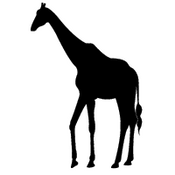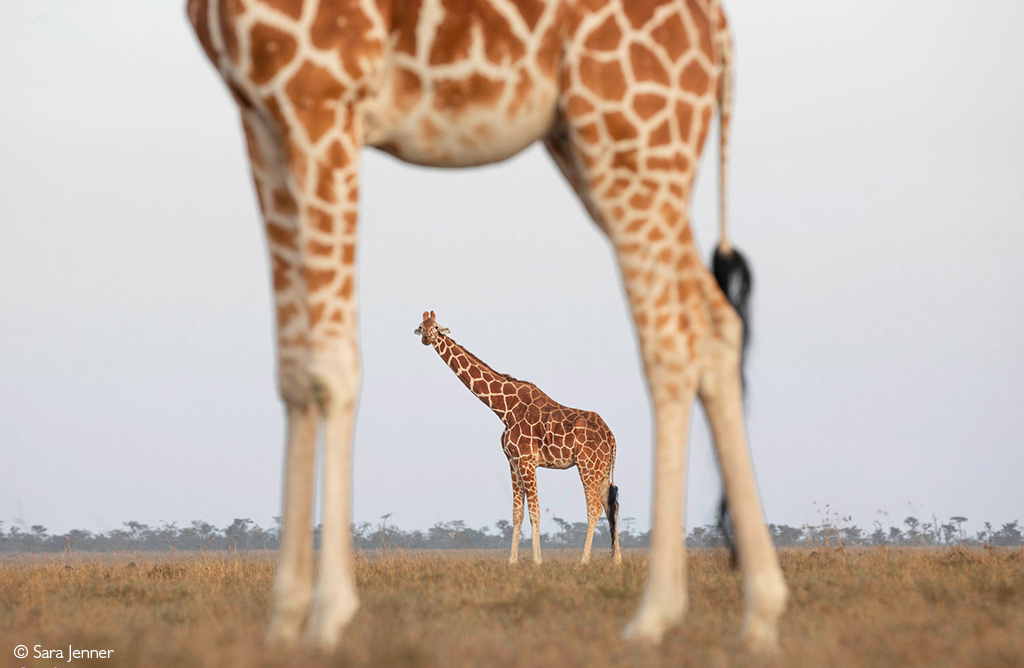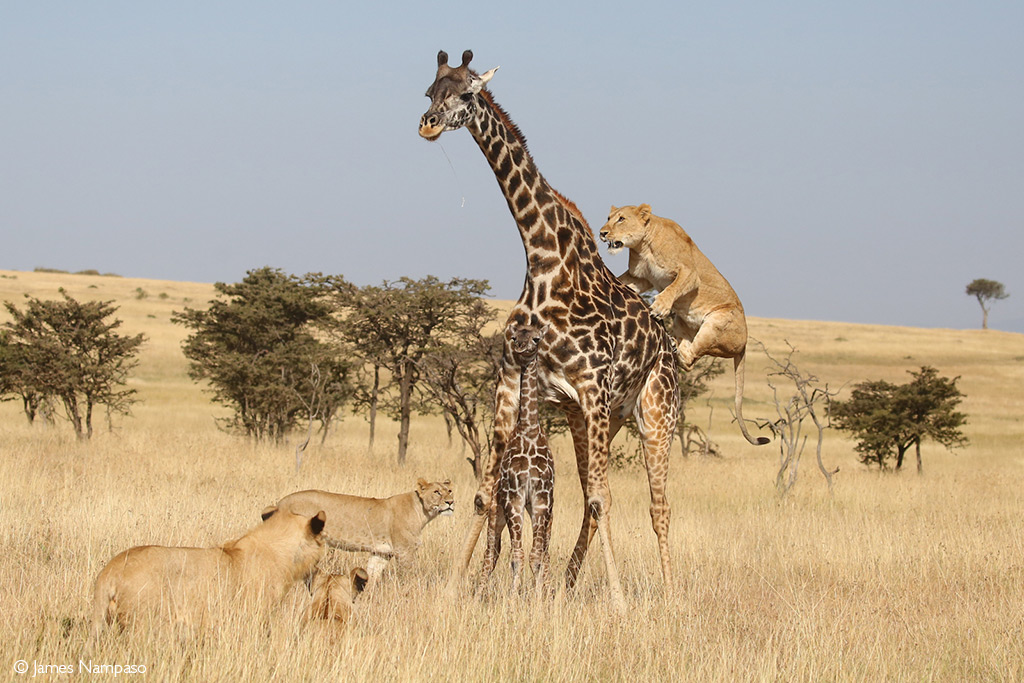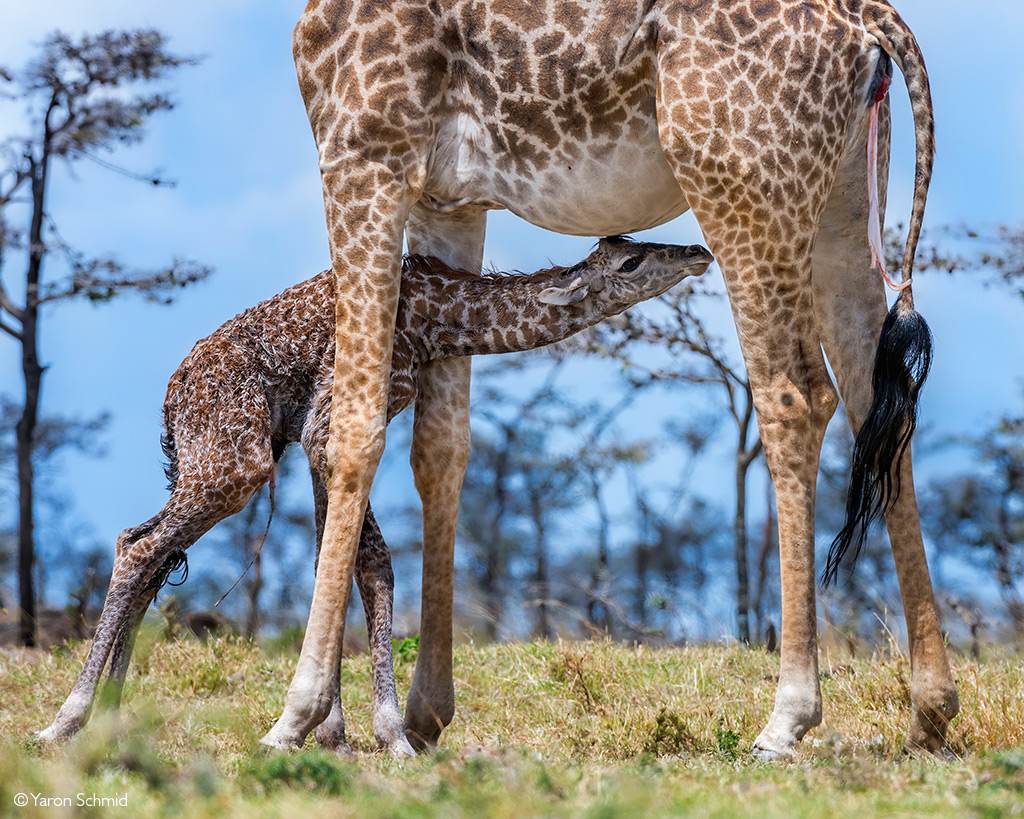
Celebrating the planet's tallest creature


Millennia of evolutionary problem-solving have conferred upon animals a weird and wonderful array of adaptations from trunks to tails and patterned coats to thick fur. Predators have been equipped with offensive weaponry, and prey species are similarly prepared to defend themselves in an eternal evolutionary arms race. The peculiar, unique creatures on the planet have been shaped by innumerable overlapping conditions never again to be repeated – every living thing is the product of circumstance. And perhaps nowhere is this more apparent than the giraffe, one of Africa’s most fantastical offerings.

In the know
As the tallest animal on Earth, giraffes do not exactly keep a low profile and probably need little by way of introduction. Their leggy silhouettes have appeared in some of the most iconic images of the continent, hordes of tourists have marvelled at their outlandish shapes, and cartoon representations abound. Yet despite their rather significant stature, these quiet and unassuming herbivores spent much of the 20th century flying under the conservation and ethological radar. They are perhaps one of the most under-studied large mammals in Africa, and scientists are only now beginning to unravel the secrets of their social lives and communication. Worse, it is only in the last decade that the reality of their “silent extinction” has made it into the public eye.
Giraffes are possibly one of the most intriguing animals on safari. While we are far from knowing everything there is to know, recent scientific discoveries around their complex physiology and behaviours are endlessly fascinating.

Quick facts
| Height: | Up to 6 m |
| Mass: | Male: 1,192kg |
| Female: 828kg | |
| Social Structure: | Loose aggregations or solitary (with evidence of longer-lasting bonds) |
| Gestation: | 460 days (15 months) |
| Conservation status: | Vulnerable |
The fast-walking leopard camel
The common name “giraffe” comes from the Arabic word zarāfah, meaning “fast-walker”, but it is the scientific name that is particularly entertaining. Until recently, all giraffes were considered one species (more on this later): Giraffa camelopardalis. “Camelopard” is an archaic English name for the giraffe, derived from Greek and referring to the giraffe’s physical similarity to a camel and the spotted, leopard-like colouration (from pardus, meaning “spotted” or “mottled”).
The characteristic pattern of dark patches on a lighter background – slightly different for each species – probably serves a thermoregulatory function, as the darker patches are rich in large sweat glands. The camel comparison is particularly relevant to their walking styles – giraffes and camels move both legs on the same side of the body simultaneously in a gait known as pacing. This confers a rocking motion to their movement and means that while they can gallop, they cannot truly trot in the way a horse or zebra can. Naturally, having legs over two metres long implies that even a leisurely stroll qualifies as fast walking. Still, giraffes can also reach speeds of over 60km/hour when forced into a reluctant run.
Despite this (admittedly tenuous) similarity, camels and giraffes are only very distantly related as members of the Artiodactyla (even-toed ungulates). The closest relative of all giraffe species is a bizarre and endangered animal called an okapi, found only in the highland forests of the Democratic Republic of the Congo.

Why the long neck (and legs)?
The famous question that has dominated scientific interest in giraffes since the Galapagos finches first lit the fire of Darwin’s interest in evolution. Giraffes proved to be the textbook example of how a physical trait of some individuals (height, stripes, spots) conferred an advantage and, over many thousands of years, became the signature look of a species. So, during times of nutritional stress, slightly taller giraffe ancestors could reach leaves above the reach of their competitors. Thus, they survived and passed the “tall gene” onto their offspring.
This is, of course, a massive oversimplification and a bit unfair to Darwin to boot. For a start, Darwin was more impressed by the giraffe’s tail as a perfectly designed flyswatter and only focussed on the giraffe’s neck in a later argument with a staunch critic. Extracting the “reasons” why an animal evolved to look the way it does will invariably produce competing theories and disagreements. It is also impossible to look at the contemporary advantages of an evolved trait and assume these explain its evolution.
As it turns out, long necks confer several advantages. For example, they increase the momentum and power of the devastating blows delivered by fighting males to rivals, suggesting a sexual competition element. A long neck (and good eyesight) is also helpful for keeping an eye out for predators. The increased surface area may aid heat dissipation to assist thermoregulation in warm climates. In simple terms, we don’t fully understand how the giraffe came to stand as tall as it does.

Gotta keep your head up
We know that the evolution of the giraffe’s six-metre height necessitated several further physiological adaptations to deal with the resultant physics. Though a full exploration of these features is beyond the scope of this article, it essentially comes down to fluid dynamics and gravity. Each of the seven cervical vertebrae can be over 28cm long, and together, these neck vertebrae comprise over 50% of the entire length of the vertebral column, raising the brain two metres above the heart. The hooves lie roughly the same distance below the heart on the opposite end.
Giraffes have relatively large hearts (though not that much heavier than would be expected for an animal of their size) and mean average blood pressure twice that of other mammals. Their heart rate ranges between 40-90 beats per minute, which is also quite fast for an animal of their size (a resting horse’s heart rate rarely goes above 20 beats per minute, by comparison). This ensures that the brain is well supplied, despite its lofty position. Tight, thick skin around the legs prevents fluid from accumulating and encourages its return to the heart via the venous network. Enormous neck veins, a muscular jugular and robust valves also help prevent the giraffe from fainting when assuming its awkward straddle to drink.
Blood flow aside, a neck that long results in several other challenges. The amount of “dead space” (the parts in our respiratory system not participating in gas exchange – the trachea, bronchi, etc.) increases due to the long trachea. As a result, giraffes have a much larger tidal volume (air breathed in and out) to compensate. As ruminants, they also have an unusually muscular oesophagus to transport the balls of cud back into the mouth.
Giraffes have a highly developed nuchal ligament that runs from the back of the head to the spinal processes of the shoulder vertebrae. The stiff band of elastic tissue helps support the muscular and heavy neck without the giraffe having to invest any energy in holding its head up. However, they need to contract these muscles against the force of the ligament to lower the head. This may have led to the misconception that giraffes sleep very little and seldom lie down. However, research shows that giraffes sleep roughly the same amount as other ruminants (a couple of hours a day – though generally in short bursts) and usually do so lying down, with the head tucked to the side and resting on their hip.

The journeys of giraffes
The life of a giraffe begins dramatically with a two-metre drop to the ground below the standing mother. Once the tiny creature has recovered from the shock of its brutal entry into the world, it immediately tries to stand; a feat made all the more challenging as a giraffe calf is already around two metres tall at birth. They are born with their ossicones folded down on the skull – these will become erect a few days later. A closer look at a giraffe calf also reveals that they are oddly disproportionate, with a (relatively) short neck, which allows them to suckle comfortably.

Giraffe calves are most vulnerable to predators during their first few weeks. Still, giraffe cows are formidable protectors and will attempt to fight off even the largest predators with potentially lethal kicks. It is not uncommon to encounter slightly older calves in a “calving pool” under the care of one female. The calves suckle for up to eight months and remain with their mothers for just over a year.
It was generally assumed that giraffes formed no lasting social bonds, but research now shows that their social dynamics are far more complex than initially believed. Females live in matrilineal societies, and associations between mothers, daughters, and grandmothers may last for years. These small kinship groups may link up with other herds for a while before separating again – a more typical fission-fusion society. Distress signs have also been observed in cows that have witnessed the death of another cow’s calf, suggesting a degree of cooperation in calf raising.
Naturally, any social structure requires communication and giraffe are not the mute creatures they were once believed to be. They have been recorded humming, snorting, grunting, moaning and even growling. Fascinatingly, they can also use infrasonic sounds to communicate below the level of human perception, like elephants.

Boys are smelly
Unlike the females, the bulls seemingly form no lasting social bonds. Once they disperse from their mothers, they may temporarily join bachelor herds but become increasingly solitary as they age. Sexual maturity is attained at around four years of age, but it may take several years until they can compete for mating rights.
A fight between two equally matched males is one of Africa’s greatest spectacles. The process is (perhaps somewhat deceptively) termed “necking” and involves swinging the neck round in powerful arcs and using the ossicones to club the flanks of a rival. The blows can be exceedingly violent, and while it is rare, such fights can be lethal. For this reason, the ossicones of bulls are far thicker, more rounded, and hairless than those of the females.
All giraffes smell somewhat pungent, but mature bulls are downright malodorous. This is because their skin is coated with copious amounts of a secretion containing 3-methylindole, a chemical responsible for the smell of mammalian faeces, and para-cresol. These substances discourage the growth of fungi and bacteria on the skin.


The Silent Extinction
Currently, the IUCN Red List recognises only one giraffe species, which is classified as “Vulnerable”. However, the most recent genetic research shows that there are four species of giraffe, three of which have several different subspecies. These are:
- Northern giraffe – Giraffa camelopardalis
- West African giraffe – G. c. peralta
- Nubian giraffe (including the Rothschild’s giraffe) – G. c. camelopardalis
- Kordofan giraffe – G. c. antiquorum
- Southern giraffe – Giraffa giraffa
- South African giraffe – G. g. giraffa
- Angolan giraffe – G. g. angolensis
- Masai giraffe (Giraffa tippelskirchi) – Giraffa tippelskirchi
- Masai giraffe – G. t. tippelsirchi
- Luangwa giraffe (often termed the Thornicroft’s giraffe) – G. t. thornicrofti
- Reticulated giraffe (Giraffa reticulata)
Though there has been considerable academic debate over the exact species/subspecies designations, the discussion is essential as it goes to the heart of conservation efforts. While giraffes across Africa may only be “vulnerable”, many species and subspecies face potential extinction due to habitat loss, bushmeat poaching, and snaring. It is helpful to consider the distinction between the four species as one might of the difference between white and black rhinos to understand how vital it is for their future.
For those wishing to make a meaningful contribution to giraffe conservation, you can visit the Giraffe Conservation Foundation’s page on our app (see instructions on how to get the app below this story).

Final thoughts
In the Southern Hemisphere, the Southern Cross constellation (Crux) revolves its way through the night sky, pointing out south for weary travellers and excited novice stargazers. In a much more exciting interpretation from some traditional Bushman stories, these four stars are two giraffes, forever wandering the inky black of night. And just as the stars are an essential element of the sky, so too are giraffes a vital part of Africa’s ecosystems, which makes it astonishing that we still know so little about them…
Further reading
For a more in-depth analysis of the giraffe species and the threats facing them, read Giraffes: The Silent Extinction
For the most recent species and subspecies classification, have a look at Four giraffe species, seven subspecies
And for the latest populations and trends, Giraffe conservation status – the latest numbers give hope!
To comment on this story: Login (or sign up) to our app here - it's a troll-free safe place 🙂.![]()






